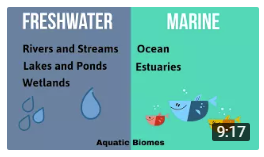As a result of the different climates biomes differ in,
Terestrial Biomes
Tropical Rainforest:
Location: Near the equator
Climate: Hot (20-25C) Very Rainy (400 cm +)
Flora: Abundant plants, trees form a canopy
Fauna: Many insects, plus the most biodiversity of all terrestial biomes.
For more on tropical rainforests this video will help.
Grassland/Savanna
A savanna biome contains a mixture of grass and trees with the trees being spaced apart so that a canopy is not formed.
Location: Africa, Portugal,Columbia, and South Wales
Climate: Warm to Hot
Rainfall 76.2-101.6 cm (30-40 inches).
Savanna's have a wet and dry season.
Wildlife: Home to several of the largest land animals like elephants, and giraffes.
For more on grasslands this video will help.
Desert
Location: Found on every continent.
Climate: Hot, dry, cool to cold nights (-18 to 50 C)
Little rain (less than 25cm)
Flora: Very little , Cacti, tumbleweed
Fauna: Little variety, many small, adapted to extreme heat or cold, and very dry conditions.
For more on deserts this video will help.
Deciduous Forest
Location : Eastern US (Kennesaw, GA) Europe, East China
Climate: Above average rainfall (75 to 125 cm), Moderate Temp. (-30 to 30C)
Vegetation: Trees drop leaves in fall, grow in spring. Oaks, Maples, leaves that change colors
Animals: Medium variety, average number of insects.
For more on deciduous forests this video will help.
Taiga/Coniferous Forest
Location: Northern Europe, Russia, Canada, Northern North America
Climate: Cold (-40 to 20C) Snowfall (30 to 90 cm)
Flora: Coniferous Trees
Fauna: Moose, Deer, Beavers, Reindeer, Bears
For more on the Taiga Biome this video will help.
Tundra
Location: Extreme north, Arctic
Climate: Very cold, dry (-40-18C)
Little rain/snow (25cm – 50cm)
Flora: few to no trees, limited plants, moss, lichen (permafrost)
Fauna: Caribou, insects in summer, wolves, birds that fly south, polar bears
In addition there are marine biomes consisting of salt water and freshwater biomes.
For more on the Tundra Biome this video will help.
 |
| Tundra Biome |
In addition you have marine and freshwater biomes. Marine biomes have a greater salinity than freshwater biomes. Aquatic Biomes can be divided into two major categories.
 |
| Aquatic Biomes |
You may also enjoy ......
Location: Near equator
Climate: Hot (20-25C)
Rainy (400 cm +)
Flora: Abundant plants, trees form a canopy
Fauna: Many insects, most biodiversity of organisms
Location: Near equator
Climate: Hot (20-25C)
Rainy (400 cm +)
Flora: Abundant plants, trees form a canopy
Fauna: Many insects, most biodiversity of organisms
Location: Near equator
Climate: Hot (20-25C)
Rainy (400 cm +)
Flora: Abundant plants, trees form a canopy
Fauna: Many insects, most biodiversity of organisms








0 comments:
Post a Comment